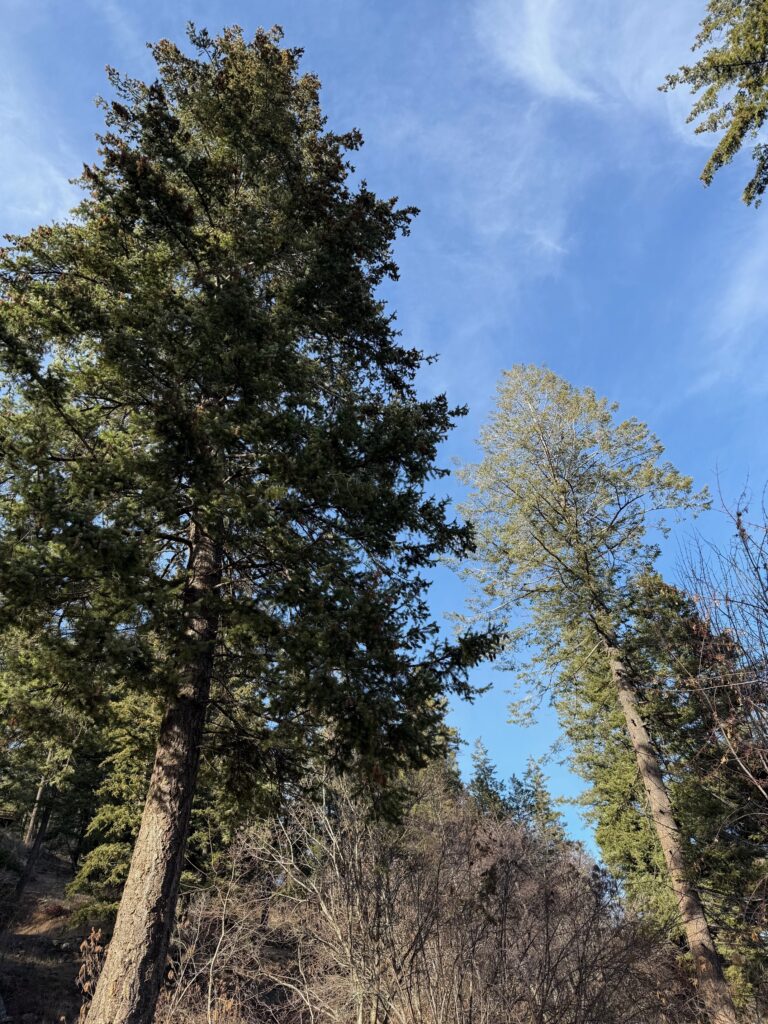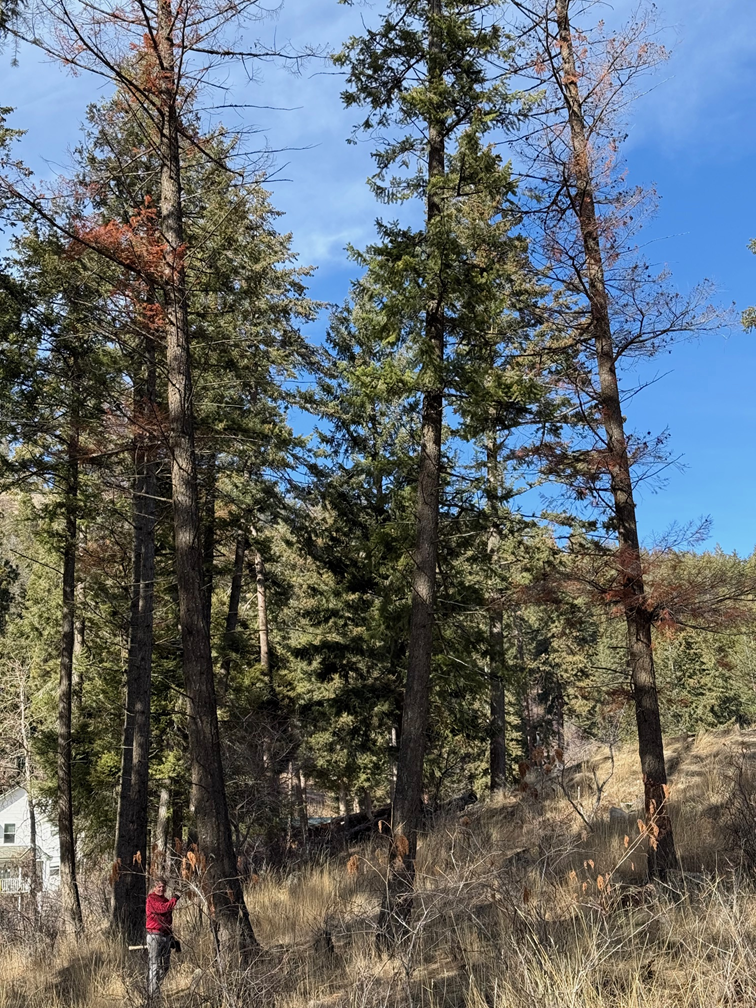Insect infestation and root disease are common issues in this area.
Idaho Department of Lands Arborist Visit, 2-27-2025
John Gaddess, IDL, visited Cape Horn Estates on February 27, 2025. He answered questions and viewed trees at several properties on Cape Horn Drive, Osprey View Lane, and Glacier Loop. Here’s a summary of what he had to say:
- Our trees are in a particularly stressful environment, because we have steep slopes and little soil. It is worth it for us to water trees that seem stressed.
- When trees aren’t able to draw enough water from their roots, either from drought or from interruptions like root rot or insect infestations that attack the phloem, they are not able to produce enough needles to gather light and create nutrients.
- The picture below shows a comparison of two trees. the one on the left is healthy; the one on the right is “fading.” It is not getting enough water to its top to support life. The best thing to do for a tree like this is to water it, every 2 weeks, 1 gallon per inch of diameter.
- Consider thinning your trees, to reduce competition for water.
- Trees are used to dealing with fungi and insects; they have natural defenses. If you see pitch on your trees, it may be that they fought — and won — a battle against something. Each battle weakens them, though, so if they get hit with insects and root rot and not enough water, it may be enough to overcome the tree.
- Bark beetles typically attack dead or dying trees. They only attack living, healthy trees when the insects are so numerous they have to find new food sources. Insects tend to attack trees that are more than 12 inches in diameter, so if a smaller tree is languishing, it is probably from root rot.
- The second picture below shows what is likely to be an insect attack (not root rot). There is a recently dead tree, then a healthy tree, then another recently dead tree. If it was root rot, it would have affected the middle tree also. The best thing to do with this situation is to check under the bark for signs of insects, and if they are present, fell the dead trees and either strip the bark open or hit it with an insecticide to kill the bug larvae before they can infect other trees. Larvae fly in late April or early May.
- In 2015, after the Cape Horn fire destroyed a lot of the beetles’ habitat nearby, the community was wise to take precautions against our trees being attacked. He did not see any reason to suppose that our neighborhood is particularly vulnerable this year.
- Despite that, if any property owners want to take precautions to ensure their trees are not attacked by Douglas Fir beetles, they should purchase the anti-aggregation pheromone MCH and attach it to individual trees or stands of trees before the beetles fly in late April or early May. Attach the packet to the north side of the tree to prevent the sun from degrading it. A packet is good for one year. MCH packets can be purchased from Forestry Distributing at www.forestrydistributing.com.
Root Disease
- Root disease causes more growth loss and mortality than any other disease in Idaho. It is caused by fungi that live under ground and attack the root systems of living trees. The disease kills the roots and continues to live in the dead root systems for decades. Trees with root systems weakened by root dis-ease are predisposed to windthrow, breakage, and bark beetle attacks. Because the disease is active underground, it can go unnoticed resulting in weakened trees that are often attacked and killed by bark beetles. Root disease is caused by several different fungi that can attack all conifer species in Idaho, especially when they are young. Grand fir and Douglas-fir are most susceptible to the disease.
- Read more in the forestry factsheet.
- How to identify severity of root disease in your trees.
- More about root disease in ponderosa pines.
Bark Beetles
- Bark beetles are a large group of forest insects that are very common in Idaho forests. There are over 400 species in North America, but the important tree-killing species that occur in Idaho are:
- Mountain Pine Beetles – attacks all pine species
- Douglas Fir Beetles – attacks Douglas fir and western larch
- Read more about dealing with Douglas Fir beetles
- Read more about secondary Douglas Fir beetles
- Western Pine Beetle – attacks ponderosa pines
- Pine Engraver – attacks most pine species
- Fir Engraver – attacks grand fir trees
- Idaho Forestry resources report that there is little that can be done to prevent infestation by Mountain Pine Beetles. Verbenone is a type of pheromone (a chemical to prevent infestation), but has shown inconsistent results. Verbenone can be purchased from the manufacturer, Synergy Semiochemical, or a distributor, Forestry Distributing.
- MCH is an effective preventive for Douglas Fir Beetles, and must be applied in the spring before new beetles start flying. It lasts one year. This paper is considered the best reference for learning about MCH. MCH can be purchased from the manufacturer, Synergy Semiochemicals, or a distributor, Forestry Distributing.

